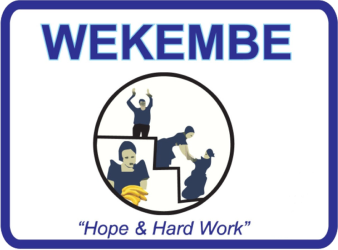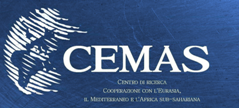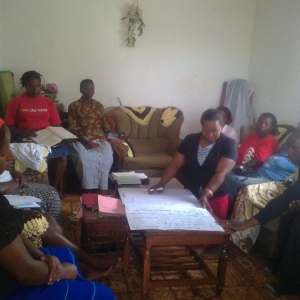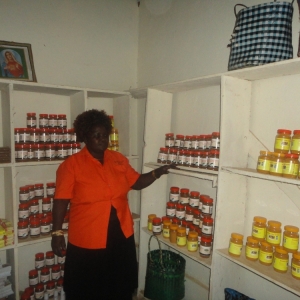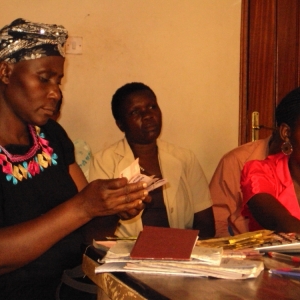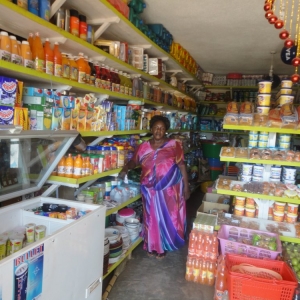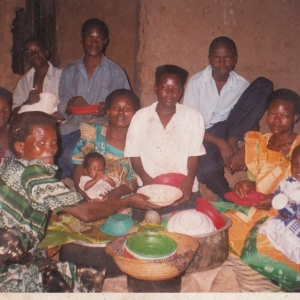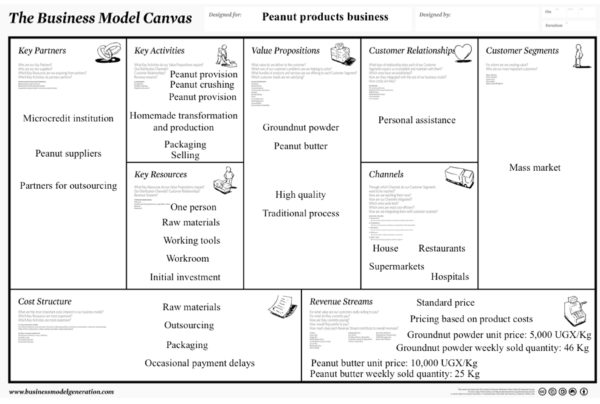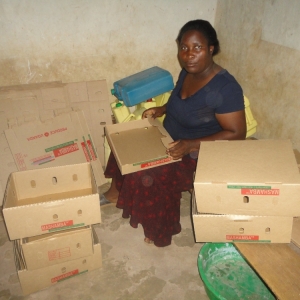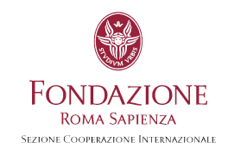The implementation of the model for a groundnut products business
The Business Model Canvas has been adopted to analyse and reproduce several business models operating in Uganda.
1. Description of the business
More precisely, the case study considered in this report concerns the investigation of a business regarding a groundnuts product manufacturer.
The business model canvas reported in Fig. 1 represents the definition of a business, which has been realised by starting from the analysis of data concerning this specific successful business, managed by a peanut products producer.
The aim of this business model canvas consists in defining and describing the successful factors characterising a peanut products business, undertaken principally by a person, supported by her relatives and reaching at least annual revenues for 24 millions Ugandan schillings and profits for 6,5 millions Ugandan schillings in a normal year.
In 2012, the producer started this business thanks to an initial investment. Subsequently, Wekembe microcredit institution gave her loans for about 500,000 Ugandan schillings to enlarge the activity and promote her business.
2. Building blocks description
Customer segments
The customer segment, which is possible to identify is composed by different kinds of people, with dissimilar ages and gender. In fact, the mass market is the reference group to which this business delivers products. Clients are also the users of these products, but it is necessary to consider also all people for whom others buy. In fact, some people purchase products for all the components of the family, especially for children, who are considered users and not buyers in this business.
In order to be more accurate, customers can be separated in loyal and new clients. The former are people who frequently buy peanut products, because they know these products and their properties. In fact, loyal clients prefer to eat more genuine product by purchasing natural handmade products, instead of buying commercial products at the supermarket. The latter represents a great potential for this business because peanut products are widely consumed among common people, due to their nutritional properties and the intense flavour. In fact, the potential for enlarging the business is great due to the difficulty to satisfy all the monthly clients demand.
Value propositions
This specific business offers two kinds of products, realised by using the same basic element, which is the peanut. In fact, the entrepreneur produces the groundnut powder and the peanut butter, as displayed in Fig. 2. These products are widely consumed by people in these areas and purchases are recurrent. The handmade production of these goods confers on them a special value in term of quality and genuineness. The adoption of few and natural ingredients allow to produce healthier products than the ones resold by supermarkets. These commercial goods, made by using chemical elements, do not produce the same intense favour because of the alteration of peanut naturalness.
The entrepreneur adopts a traditional process to transform her raw materials in final products. This is considered a major value for customers, who prefer to pay a higher price for more genuine products, compared to commercial products sold by large retailers.
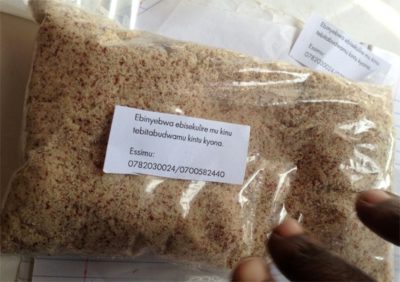
Fig. 2: Groundnut powder
Channels
The products mentioned above are delivered through several channels such as the entrepreneur’s house, restaurants, supermarkets and direct sales to hospitalised people.
The entrepreneur’s house is the place where also the production occurs and this is mostly frequented by loyal clients and village people, who has good product awareness and who want also benefit from special discounts on the final price. More precisely, the selling price is standard for all the adopted channels. The price adopted for restaurants and supermarkets is the same applied to common customers. In this case, the entrepreneur might yield small discounts to local people, in order to promote their support, especially in feeding.
Groundnut powder and peanut butter purchased by restaurants ensures a weekly demand of 36 kilograms for both products.
The amount of products demanded by supermarkets is about 40 kilograms every 2 weeks and 5 kilograms for hospitalised clients each week.
Customer relationships
Considering the house as the major adopted channel to deliver products and the direct contact with hospitalised people, the customer relationship that emerges is characterised by personal assistance. This confidential state allows the entrepreneur to keep and grow a sustainable relationship with her clients. In this way, the manufacturer may better understand also clients’ requirements and preferences, in order to adapt the products to specific desires.
On the other side, the adoption of restaurants and supermarkets does not allow the entrepreneur to keep a personal relationship with the final clients. This situation may incur in some difficulties, due to the lack of control that the entrepreneur exerts on the distribution channel. In this specific business, as the potential demand is high and the presence of competitors is almost absent, the risk to be overcome from other producers is low. In fact, restaurants and supermarkets may not have reasons to promote competitors’ products instead of the considered ones, also for the high quality characterising these peanut goods.
Revenues streams
As mentioned above, the purchases of groundnut powder and peanut butter are extremely frequent. These commodities have standard selling prices although several channels sell them. The pricing is mainly based on product costs, such as expenses for raw materials, the packaging, the transportation and labour.
Each week, clients demand maximum about 100 kilograms of products and in average 70/80 kilograms.
By considering weekly revenues for groundnut powder around 230,000 Ugandan schillings and its unit price at 5,000 Uganda schillings, it is possible to figure out 46 kilograms as the total weekly requested amount. Moreover, as weekly profit for this product is 1,800 Ugandan schillings and considering 50 weeks in the whole year, the annual profit for groundnut powder is about 4 millions Ugandan schillings and annual revenues about 11,5 millions Ugandan schillings.
On the other side, weekly revenues for peanut butter are nearby 250,000 Ugandan schillings and its unit price at 10,000 Ugandan schillings. This leads to identify 25 kilograms of products sold each week. As the weekly profit for peanut butter is about 2,000 Ugandan schillings, it is possible to set an annual profit of 2,5 millions Ugandan schilling, by considering 50 weeks in the whole year; annual total revenues are round 12,5 millions Ugandan schillings.
As it is possible to induce from data reported above, the peanut butter ensures smaller profit margins than groundnut powder because the former has higher realisation costs to support. Due to the typology of the product, it requires a more expensive packaging, such as a glass jar with label and the implementation of more ingredients.
Almost all clients pay instantaneously for their purchases and just few of them demand for delays in payment.
Key resources
The realisation and continuity of this business requires at least one person, who works in average 8 hours each day. In order to fully satisfy customer demand in most profitable months, the entrepreneur may employ some relatives to help her in developing some critical activities. By adopting this solution, she will save incremental labour costs by offering insignificant recognitions to these collaborators.
Raw materials are essential to start the homemade production of peanuts products; among these components it is possible to identify peanuts, oil and sesame.
The entrepreneur principally works at home, where she might use a room to realise her laboratory and save financial resources to invest. In this workroom, it is necessary to dispose of some working tools, such as 2 mortars, one sieve and a packing machine, as displayed in Fig. 3 and Fig. 4.
The initial investment required is about of 20,000 Ugandan schillings, in order to buy some basic raw materials and fundamental tools to start the production. Microcredit institution can support the business by granting loans to promote a good activity and ensure its sustainability or growth.
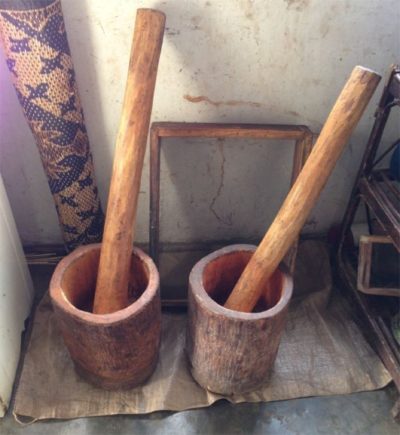
Fig. 3: The mortars
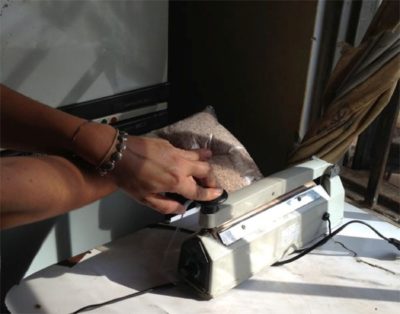
Fig. 4: The packing machine
Key partners
As mentioned above, in order to fully satisfy clients demand, the entrepreneur might ask the help of her relatives to develop some activities. By doing that, she will save labour costs and deal with uncertainties, which occur without regularity.
As peanuts are the fundamental elements to realise products, the entrepreneur keeps continuous relationships with peanuts suppliers, in order to ensure an incessantly availability to make the production sustainable in the long term.
Microcredit institutions let the business start and benefit from granted loans, necessary to enlarge the activity and support the entrepreneur during periods of limited cash availability. This is important, also because loans are used not only to ensure continuity in the production, but entrepreneurs also support their family by buying basic commodities.
Collaborators, who let the entrepreneur outsource some phases related to peanut butter production, represent the most relevant partners for this kind of business. In fact, the realisation of peanut butter requires a specific machine, which is considered too expensive for the entrepreneur to invest in. This specific tool is necessary to be adopted at the beginning of the production process. The outsourcing allows the manufacturer to press peanuts until it reaches the right consistency to start the production of butter, by adding oil and sesame. This collaboration results to be extremely important because the entire process of pressure lasts the whole day and the entrepreneur has to rely on the availability of these partners.
Key activities
The production process starts with the provision of peanuts from suppliers, to ensure the right amount of raw materials to satisfy the clients’ demand.
Considering the two typologies of the products produced, the process of realisation is quite different. By considering the groundnut powder, the entrepreneur personally presses the peanuts in mortars until they become powder, as represented in Fig. 5. This process requires high physical energy because the beating of peanuts lasts for long and it is a manual activity. After having produced this grind, maximum 25 kilograms per day, the entrepreneur sieves it with the specific tool, as displayed in Fig. 6. Subsequently, the sieved powder is packed in specific plastic bags and it is ready to be sold to the final client.
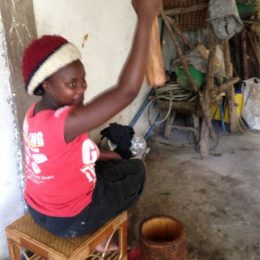
Fig. 5: The manual pressure of peanuts
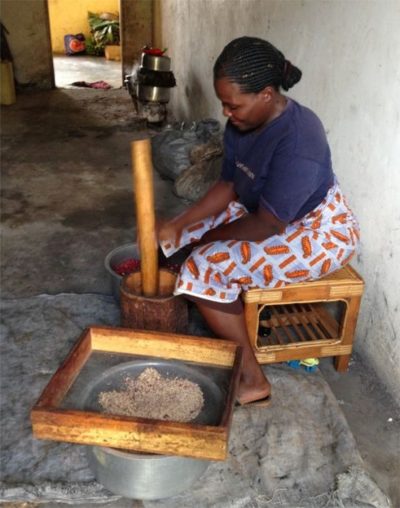
Fig. 6: The powder sieving
By considering peanut butter production, after the peanuts provision, the entrepreneur has to outsource the roasting and the machining of these nuts, in order to obtain the prepared to start the production of butter. Afterward, the entrepreneur 34 personally adds sesame and oil to this grind and manually works the mixture until it become creamy. The maximum daily butter production is about 20 kilograms.
After the handmade production, the products need to be packed before starting the selling process. The packaging is different for both products, due to their consistency. The plastic bag is enough to protect groundnut power, but the adoption of a glass jar.
Once the product is packed, it is ready to be sold to different distribution channels.
Cost structure
This business is characterised by instant payments by the entrepreneur to peanuts suppliers.
By considering the unit selling price and profits for each kilogram for groundnut powder, it is possible to figure out the amount of cost necessary to support the realisation of the product, which is about 3,200 Ugandan schillings. This sum comprises costs for raw materials and packaging. By considering monthly costs, the total amount is about 150,000 Ugandan schillings. The price for plastic bags to pack almost 20 kilograms of powder is 3,000 Ugandan schillings.
The unit cost incurred to realise butter is higher than the one concerning the groundnut powder. In fact, by deducing the profit for kilogram from the unit-selling price it is possible to figure out a unit cost of 8,000 Ugandan schillings that results to be nearby 200,000 Ugandan schillings per week. As mentioned at the beginning, this greater amount occurs for the higher costs for packaging and additional outsourcing activities. The mincing at partners costs about 100 Ugandan schillings per kilogram.
The other costs supported to realise the activity concern both mortars, each at 3,000 Ugandan schillings, and the packing machine at 80,000 Ugandan schillings. These depreciations are not considered in the identification of cost items for each product. The same treatment occurs also for the entrepreneur labour salary, which is included in the amount of revenues.
